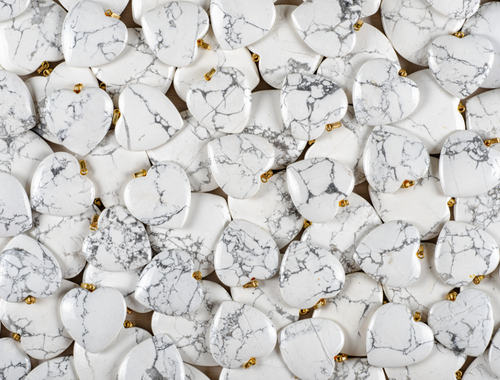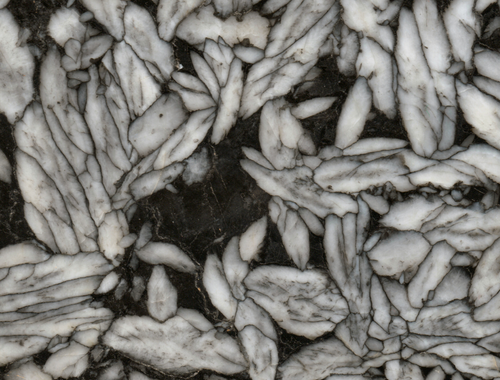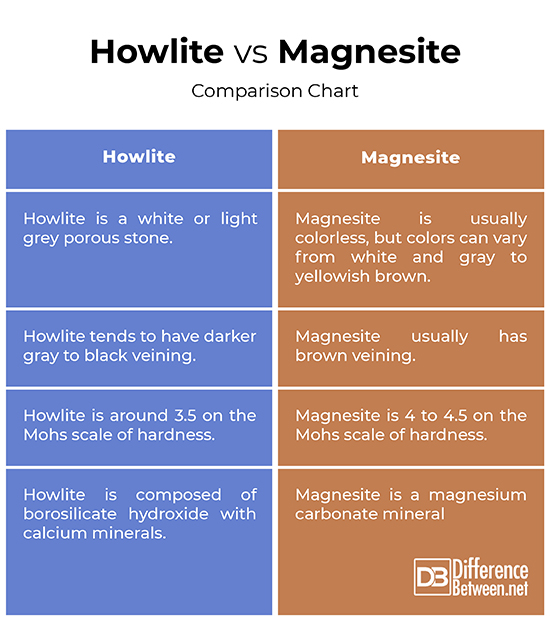Difference Between Howlite and Magnesite
Some rocks and gemstones are fairly easy to identify, but hidden gems like howlite and magnesite which are sometimes dyed and sold as turquoise can be a little tricky to identify. When you look at them, they may seem identical, and when dyed blue, they could imitate a variety of turquoise colors. Both are naturally white occurring minerals found in crystal forms, however, both are chemically very different minerals with very different cleavage grades. We break down the key differences between the two rocks to help you better understand them.

Howlite
The howlite stone is often misunderstood for a real gemstone, but the fact is that it’s perhaps best known as an imitation stone. Howlite is a white or light grey porous stone found in evaporate deposits. The most common form of howlite is irregular nodules, sometimes resembling cauliflower. It is basically a borate mineral found in sedimentary rock. The scientific name of howlite is silico-boro-calcite, otherwise known as White Buffalo Turqouise. It is also sold in its natural state. Crystals of howlite are quite rare. They are commonly used to make decorative objects such as small carvings or jewelry components. It is soft and porous with hardness level of 3.5 Mohs.

Magnesite
Magnesite is a magnesium carbonate mineral that belongs to the calcite group of carbonate minerals. In its original form, it is often used in chemical and steel industries. The gem-quality magnesite is extremely rare and beautiful, with colors ranging from white and gray to yellowish brown, and sometimes, colorless. It has a chalky and porous texture. Like howlite, it is skillfully dyed to colors very similar to turquoise. It is formed as a result of metamorphism or chemical weathering of carbonated rocks or magnesium-rich rocks. It is a soft gemstone like howlite, so utmost care should be taken because they are prone to scratches.
Difference between Howlite and Magnesite
Chemical Composition
– Both are naturally white occurring minerals found in crystal forms and they both look identical, and when dyed blue, they could imitate a variety of turquoise colors. Howlite is a borate mineral and is scientifically called silico-boro-calcite. It is composed of borosilicate hydroxide with calcium minerals. Magnesite is a magnesium carbonate mineral formed by alternating monolayers of carbonate groups, iron II carbonate, and magnesium.
Color
– Howlite is a white or light grey porous stone found in evaporate deposits. Natural howlite is white stone with a slight blend of gray or dark veins. In its natural state, it is naturally white or gray, marked with black or dark brown veining. Magnesite, on the other hand, in its purest form, is usually colorless. But there are magnesites which vary in color ranging from white and gray to yellowish brown and lilac rose. It also appears faintly pink in color because of the traces of iron, copper, manganese, and nickel.
Structure
– Both howlite and magnesite are soft and porous gemstones, but with very distinct hardness levels. Magnesite has a perfect cleavage in three directions, so faceting becomes very difficult. Magnesite is 4 to 4.5 Mohs on the scale of hardness. Howlite is around 3.5 on the Mohs scale of hardness, which means it is relatively a soft stone
Howlite vs. Magnesite: Comparison Chart

Summary
Dyed magnesite and howlite are the two very common minerals used to imitate colors of turquoise, especially in the beading and jewelry market. From the outside, it is very difficult to tell the one apart from the other. Both are often used as cheap alternatives to turquoise. They are somewhat easy to identify when they are in their raw form. Magnesite feels kind of sticky to the tongue. Magnesite is an important mineral for the chemical industry. One of the primary differences between the two minerals is that magnesite is relatively stronger than howlite, however, neither of them are known for their durability.
Is magnesite white howlite?
Both are white decorative gemstones that imitate a variety of turquoise colors. Stones sold as howlite may actually be magnesite and vice-versa.
How do you know if something is howlite?
Holwite is primarily gray or white in its natural form and when dyed blue, can imitate turquoise. It is difficult to tell the howlite apart from the real turquoise but if it scratches easily, then you can know it is howlite because real turquoise is really hard to scratch.
What else looks like howlite?
Magnesite looks almost identical to howlite. In fact, in their natural state, it is very difficult to tell one apart from the other. The colors are very similar too. Other imitations include plastic, epoxy, and resin.
What is the use of magnesite?
Magnesite mainly serves as a refractory material for the steel industry and as a lining in furnaces and cement kilns.
What is magnesite worth?
Magnesite is a rare earth mineral which are dyed to imitate other stones. In 2021, the magnesium market was valued at around $7.5 billion and is projected to reach a whopping $10+ billion by 2028.
Are magnesite and howlite the same thing?
Both are naturally white occurring minerals found in crystal forms, but both are chemically very different minerals with very different cleavage grades and hardness levels.
What is howlite good for?
Howlite is often highly regarded as a spiritual stone that signifies patience and calm. The stone represents peace and balance, and it helps you feel relaxed and at peace.
What does howlite mean spiritually?
Howlite is a stone of patience and perspective which contributes greatly to aiding in physical health. It strengthens memory and calms the body, mind, and spirit. It is believed to be an emotional stone and is often used by practitioners for spiritual purposes, particularly it helps calm their mind.
Is magnesite a mineral or rock?
Magnesite is a rare earth mineral that is extremely rare and beautiful.
- Difference Between Caucus and Primary - June 18, 2024
- Difference Between PPO and POS - May 30, 2024
- Difference Between RFID and NFC - May 28, 2024
Search DifferenceBetween.net :
Leave a Response
References :
[0]Dellaccio, Tanya. Tunneling for Turquoise. New York City, United States: Rosen Publishing, 2017. Print
[1]Lowry, Joe Dan. Turquoise. Utah, United States: Gibbs Smith, 2010. Print
[2]Franks, Leslie J. Stone Medicine: A Chinese Medical Guide to Healing with Gems and Minerals. New York, United States: Simon and Schuster, 2016. Print
